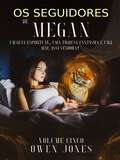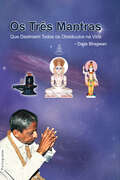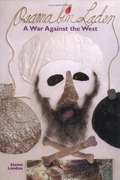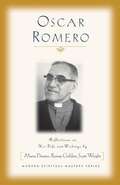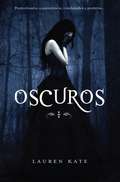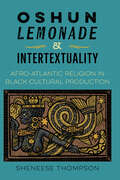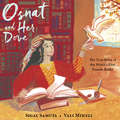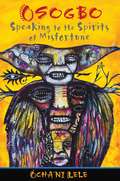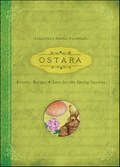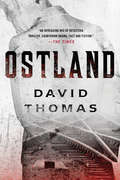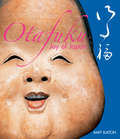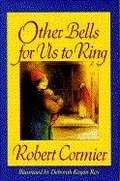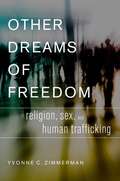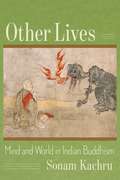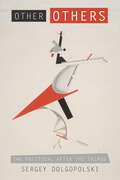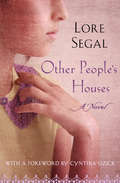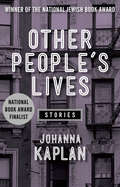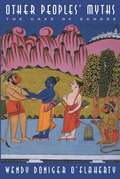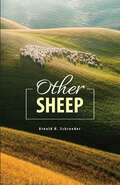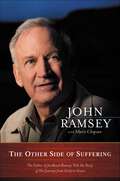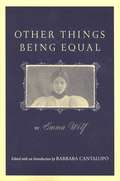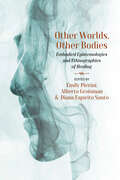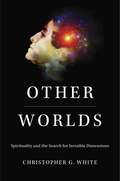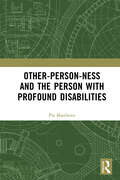- Table View
- List View
Os Seguidores de Megan: Um guia espiritual, uma tigresa fantasma e uma mãe assustadora! (A série Megan #5)
by Owen JonesUm guia espiritual, uma tigresa fantasma e uma mãe assustadora! Megan recebe permissão para realizar uma das suas ambições: entrar no Facebook e no Twitter! Megan é uma garota de treze anos com poderes sorenaturais. Alguns ainda estão apenas parcialmente desenvolvidos e outros já são mais fortes, mas ela ainda não sabe como usá-los. Seu maior problema nesse momento é encontrar um Professor capaz de lhe mostrar como lidar com eles apropriadamente. Outra dificuldade é o fato de não conhecer ninguém que saiba algo sobre poderes sobrenaturais. Na verdade, sua mãe é violentamente contra qualquer coisa que seja sobrenatural, assim como sua mãe antes dela. As únicas pessoas que parecem estar dispostas a ajudá-la estão mortas; não que isso faça alguma diferença para Megan. Ela aceita essa ajuda de braços abertos. Os Seguidores de Megan se refere aos seus seguidores na Internet. Como acabou de completar treze anos, seus pais e os grandes sites agora permitem que ela os use, então Megan faz contas no Twitter, Facebook e LinkedIn. Wacinhinsha lhe dá uma lição sobre comunicação e como percebê-la em um nível espiritual.
Os Três Mantras
by Dada BhagwanAs religiões desse mundo preservam o conhecimento e protegem os segredos dos antigos e poderosos mantras. No coração da religião desse mundo, e entre os mantras mais poderosos da história da religião, está o mantra Navkar, ou Trimantra. No livro “Trimantra”, Gnani Purush (personificação do autoconhecimento) Dada Bhagwan explica o Trimantra, seu significado e os benefícios extraordinários de recitá-lo. Aquele que desejar viver sem se preocupar enquanto enfrenta problemas na vida cotidiana, que quer saber como obter paz interior ou aquele que está em uma busca espiritual ou na busca da iluminação (auto-realização), a utilização do Trimantra fornece tudo isso - e muito mais. Entre os muitos livros espirituais disponíveis hoje, a orientação espiritual de Param Pujya Dadashri sobre o valor do Trimantra é a melhor maneira de acessar seu poder espiritual, e isso é inestimável.
Osama Bin Laden: A War Against the West
by Elaine LandauPresents biographical information about militant Islamic leader Osama bin Laden, including his role in international terrorism and the beliefs that fuel his actions.
Oscar Romero: Reflections on His Life and Writings (Modern Spiritual Masters Series)
by Renny Golden Scott Wright Marie DennisOriginally published on the twentieth anniversary of his death, this volume celebrates the life, spirit and legacy of Oscar Romero, the martyred archbishop of San Salvador.
Oscuros
by Lauren KatePredestinados a encontrarse, condenados a perderse... Hay algo dolorosamente familiar en Daniel Grigori. Misterioso y reservado, capta la atención de Luce Price desde el mismo momento que lo ve en su primer día en el internado Sword & Cross en Savannah. Eìl es lo único que la alegra en un sitio donde los móviles están prohibidos y las cámaras de seguridad te siguen a cada paso. Sólo hay un problema: Daniel no quiere tener nada que ver con ella --y así se lo ha hecho entender. Pero Luce no lo puede dejar ir. Irremediablemente atraída, está empeñada en averiguar qué secretos guarda Daniel tan desesperadamente... aunque le cueste la vida. En el proceso, Luce descubrirá que esta historia de amor aparentemente nueva tiene un origen que, en realidad, se remonta miles de años atrás --un origen más trágico y formidable de lo que nunca podía haber imaginado.Saga romántica llena de amantes condenados, ángeles caídos, seres inmortales y memorias perdidas, Oscuros es una emocionante historia de amor en cuyo corazón yace la pregunta ¿qué pasaría si nunca pudieras estar con tu alma gemela?
Oshun, Lemonade, and Intertextuality: Afro-Atlantic Religion in Black Cultural Production
by Sheneese ThompsonExploring how Afro-Atlantic religion has been used to portray Black womanhood by writers and artists from Beyoncé to Ntozake Shange In this book, Sheneese Thompson analyzes works of film and literature to explore how Afro-Atlantic religion intersects with themes of resilience in Black femininity and womanhood. Focusing on Beyoncé’s visual album Lemonade, Thompson examines iconography of the Yoruba goddess Oshun, represented by rivers, the color yellow, and other symbols. Thompson argues that Beyoncé’s tribute to Oshun creates a narrative of self-repossession amid external definitions, generational trauma, and emotional violence and draws connections to other works that feature similar religious references. Oshun, “Lemonade,” and Intertextuality also explores Beyoncé’s album Black Is King, the television series She’s Gotta Have It, Julie Dash’s movie Daughters of the Dust, Ntozake Shange’s novel Sassafrass, Cypress & Indigo, and Jamaica Kincaid’s stories in At the Bottom of the River. These works highlight the significance of African traditional religions for the healing and transformation of their characters. Thompson discusses the ways in which Yoruba and Lucumí imagery and practices such as oríkì, or praise poetry, have long been incorporated into Black cultural texts such as these to tell stories of racial and gender-based injustices. In looking at Lemonade together with influential older texts created by Black women, Thompson establishes the use of Afro-Atlantic religion—to think through Black womanhood, to explore self-defined sexuality—as a central tenet of Black women’s literature, one that these artists and writers have brought to the global stage. Publication of this work made possible by a Sustaining the Humanities through the American Rescue Plan grant from the National Endowment for the Humanities.
Osnat and Her Dove: The True Story of the World's First Female Rabbi
by Sigal SamuelOsnat was born five hundred years ago – at a time when almost everyone believed in miracles. But very few believed that girls should learn to read.Yet Osnat's father was a great scholar whose house was filled with books. And she convinced him to teach her. Then she in turn grew up to teach others, becoming a wise scholar in her own right, the world's first female rabbi!Some say Osnat performed miracles – like healing a dove who had been shot by a hunter! Or saving a congregation from fire!But perhaps her greatest feat was to be a light of inspiration for other girls and boys; to show that any person who can learn might find a path that none have walked before.
Osogbo: Speaking to the Spirits of Misfortune
by Ócha'Ni LeleBy understanding osogbo, the spirits of misfortune, we can better overcome them and return to health and balance in our lives • Explains how misfortune works in this world as living spirits that plague humanity but are also a catalyst for self-development and conscious evolution • Shows that we can overcome osogbo through ebó, sacrifice, and hard work as prescribed by consulting the orishas through the casting of the diloggún • Shares more than 40 ancient African sacred stories about the spirits of osogbo Beginning with the story of his goddaughter's battle with stage IV cancer, Lucumi priest Ócha'ni Lele explains the role of osogbo, or misfortune, in our lives. While everyone seeks blessings in life, undeserved blessings make us weak and lazy. It is tragedy that encourages us to grow and persevere. Exploring the Lucumí beliefs regarding osogbo, he shows that the Lucumí faith is neither fatalistic nor defeatist but healing and life affirming. He shares more than 40 patakís--stories stemming from the ancient Yoruba of West Africa--about the different spirits of osogbo, who like the orishas once walked the earth in human bodies. He explains the place of these spirits within the 256 odu of the diloggún, the divination system used in Santería to receive guidance from the orishas. Lele shows that the spirits of osogbo are not only concepts but also real deities and that we can, if we understand their nature, fight them through ebó, sacrifice, and hard work. He reveals how the osogbos see themselves as entities of misfortune who stand against life and all that is good in the world, but in truth it is misfortune that strengthens us, misfortune that motivates us, and misfortune that brings great evolution to the world. As the author shows, “Without bitterness, one could not know sweetness.” Likewise, without misfortune in our lives, we would never know blessings or what it means to be blessed.
Ostara: Rituals, Recipes & Lore for the Spring Equinox (Llewellyn's Sabbat Essentials)
by LlewellynCelebrate the season of returning sunlight and the bursting forth of the birds, bees, and treesOstara—also known as the Spring Equinox—is a time of renewal, a time to plant seeds as the earth once again comes to life. This guide to the history and modern celebrations of Ostara shows you how to perform rituals and work magic to renew your power and passion for living and growing.RitualsRecipesLoreSpellsDivinationCraftsCorrespondencesInvocationsPrayersMeditationsLlewellyn's Sabbat Essentials explore the old and new ways of celebrating the seasonal rites that are the cornerstones of the witch's year.
Ostland
by David ThomasBased on a horrifying true story of one of the Holocaust's worst Nazi war criminals comes a crime thriller that combines a police procedural, courtroom thriller, and a fast-paced war-time narrative. In Ostland David Thomas confronts the question of how does one man charged with eradicating evil become one of its greatest perpetrator. In wartime Berlin the brilliant, idealistic young detective Georg Heuser joins the Murder Squad in the midst of the biggest manhunt the city has ever seen. A serial killer is slaughtering women on S-Bahn trains and leaving their battered bodies by the tracks. Heuser must confront evil eye-to-eye as he helps track down the murderer. Soon after, Heuser is promoted by the SS and sent off to oversee the systematic murder of thousands of Jews in the new empire the Nazis call Ostland. Years after the end of the war Heuser thinks his diabolical past has been forgotten. Yet, an enterprising young lawyer, Paula Siebert, searching through Soviet archives, discovers Heuser and his fellow officers' crimes. Siebert is haunted by one question: how could a once decent man have become a sadistic monster? Desperate to cover his tracks, Heuser uses his training as a lawyer and years as a police detective to distance himself from his co-conspirators and escape justice. Ostland is a gripping detective thriller, a harrowing account of the Holocaust and a thought-provoking examination of the human capacity for evil.
Oswald Chambers: Abandoned to God
by David MccaslandIn Oswald ChambersAbandoned to God, you trace the life of this servant of God from his boyhood home in Scotland through an astounding journey of faith and trust in God's provision. From the United Kingdom, the United States, Japan, and ultimately to a YMCA training camp in Egypt during World War I, you'll find Chambers to be a man utterly devoted to God, His Word, and to sharing the timeless wisdom of the Bible with others. The last six years of his life were spent as principal of the Bible Training College in London and as chaplain to British Commonwealth troops in Egypt during World War I. After Chambers died, at age 43 in 1917, the books that bear his name were compiled by his wife from her own verbatim shorthand notes of his talks. Chambers never lived to see the book for which he is best known, My Utmost for His Highest, published. He left a spiritual legacy that has touched men, women, politicians, and preachers ever since. Now you can read about this remarkable life well-lived and find inspiration to persevere for the sake of Christ.
Otafuku: Joy of Japan
by Yutaka Satoh Amy Slyvester KatohWith dozens of color photographs and fun, informative text, this guide to Japanese otafuku is a delight for collectors or Japanese culture enthusiasts.Anywhere you go in Japan you are likely to encounter the plump, smiling image of Otafuku. <P><P>Author Amy Sylvester Katoh traces the roots and folk beginnings of this mythic figure, showing Otafuku's many delightful identities, and providing a magical glimpse into this charming character who has become a national icon.With a mixture of poems, photographs, anecdotes, and stories, she presents a veritable treasure chest of surprises that is sure to enchant readers.
Other Bells for Us to Ring
by Robert Cormier[From the front flap:] "At eleven, Darcy has never had a best friend, but this summer she's met the unsinkable Kathleen Mary O'Hara, who, like Darcy, is an outsider in Frenchtown. Darcy has never lived for long in any one place, but it's wartime and her father is in the army somewhere in Europe. Because her own family is Unitarian, Darcy is spellbound by Kathleen Mary's vivid tales about Catholicism. But after that careless baptism, she's stunned. A bit of holy water can't make you a Catholic, or can it? Was Kathleen Mary joking? Must she now go to church every Sunday? Can she eat meat on Friday? Then Kathleen Marry and her family disappear from Frenchtown, and Darcy waits in vain for word from her friend who promised she'd never leave her. Soon after, Darcy learns that her father is missing in action. Desperate and forlorn, Darcy seeks out an old nun known for her spiritual wisdom. Religion is about love, the nun tells her, and about miracles. It's Christmas now, but Darcy remains unsure about the power of God's love until she gets a message from Kathleen Mary--in the form of a miracle. Robert Cormier's first book for children is a touching and profound portrayal of Darcy's curiosity--and doubt--about faith that will appeal to all those who struggle to make sense of a bewildering world." Readers will sympathize with the feelings of eleven-year-olds and learn about life and situations of families whose loved ones served in the armed forces during World War II. Practices of Catholicism and Unitarianism are seen simply through the eyes of children and the point made that there are many ways to God which, no matter what the religion, involve faith and love.
Other Dreams of Freedom: Religion, Sex and Human Trafficking
by Yvonne C. ZimmermanYvonne C. Zimmerman offers a groundbreaking exploration of the relationship between freedom and sexual regulation in American anti-human trafficking law and policies. . She argues that the religious values of American Protestantism have indelibly shaped the federal government's approach to engaging human trafficking, and that the trajectory of the U.S.'s anti-trafficking efforts cannot be fully grasped without understanding the unique ways in which sex, morality, and freedom are connected in Protestant Christian configurations of morality.
Other Lives: Mind and World in Indian Buddhism
by Sonam KachruHuman experience is not confined to waking life. Do experiences in dreams matter? Humans are not the only living beings who have experiences. Does nonhuman experience matter? The Buddhist philosopher Vasubandhu, writing during the late fourth and early fifth centuries C.E., argues in his work The Twenty Verses that these alternative contexts ought to inform our understanding of mind and world. Vasubandhu invites readers to explore experiences in dreams and to inhabit the experiences of nonhuman beings—animals, hungry ghosts, and beings in hell.Other Lives offers a deep engagement with Vasubandhu’s account of mind in a global philosophical perspective. Sonam Kachru takes up Vasubandhu’s challenge to think with perspective-diversifying contexts, showing how his novel theory draws together action and perception, minds and worlds. Kachru pieces together the conceptual system in which Vasubandhu thought to show the deep originality of the argument. He reconstructs Vasubandhu’s ecological concept of mind, in which mindedness is meaningful only in a nexus with life and world, to explore its ongoing philosophical significance. Engaging with a vast range of classical, modern, and contemporary Asian and Western thought, Other Lives is both a groundbreaking work in Buddhist studies and a model of truly global philosophy. The book also includes an accessible new translation of The Twenty Verses, providing a fresh introduction to one of the most influential works of Buddhist thought.
Other Others: The Political after the Talmud
by Sergey DolgopolskiDenying recognition or even existence to certain others, while still tolerating diversity, stabilizes a political order; or does it? Revisiting this classical question of political theory, the book turns to the Talmud. That late ancient body of text and thought displays a new concept of the political, and thus a new take on the question of excluded others. Philosophy- and theology-driven approaches to the concept of the political have tacitly elided a concept of the political which the Talmud displays; yet, that elision becomes noticeable only by a methodical rereading of the pages of the Talmud through and despite the lens of contemporary competing theological and philosophical theories of the political. The book commits such rereading of the Talmud, which at the same time is a reconsideration of contemporary political theory. In that way, The Political intervenes both to the study of the Talmud and Jewish Thought in its aftermath, and to political theory in general.The question of the political for the excluded others, or for those who programmatically do not claim any “original” belonging to a particular territory comes at the forefront of analysis in the book. Other Others approaches this question by moving from a modern political figure of “Jew” as such an “other other” to the late ancient texts of the Talmud. The pages of the Talmud emerge in the book as a (dis)appearing display of the interpersonal rather than intersubjective political. The argument in the book arrives, at the end, to a demand to think earth anew, now beyond the notions of territory, land, nationalism or internationalism, or even beyond the notion of universe, that have defined the thinking of earth so far.
Other People's Houses: A Novel
by Lore SegalWith a foreword by Cynthia Ozick, this semiautobiographical novel of a Jewish girl forced away from home in the face of Nazi persecution is an extraordinary tale of fortitude and survivalOn a December night in 1938, a ten-year-old girl named Lore is put on the Kindertransport, a train carrying hundreds of Jewish children out of Austria to safety from Hitler&’s increasingly alarming oppression. Temporarily housed at the Dover Court Camp on England&’s east coast, Lore will find herself living in other people&’s houses for the next seven years: the Orthodox Levines, the Hoopers, the working-class Grimsleys, and the wealthy Miss Douglas and Mrs. Dillon.Charged with the task of asking &“the English people&” to get her parents out of Austria, Lore discovers in herself an impassioned writer. In letters to potential sponsors, she details the horrors happening back at home; in those to her parents, she notes the mannerisms and reactions of the new families around her as she valiantly tries to master their language. And the closer the world comes to a new war, the more resolute Lore becomes to survive.As powerful now as when it was first released fifty years ago, Other People&’s Houses is a poignant tale about the creation of a new life in the face of hopelessness and fear—a hallmark of the postwar immigration experience.
Other People's Lives: Stories
by Johanna KaplanFinalist for the National Book Award and winner of the Jewish Book Award: A collection of five stories and one novella from Johanna Kaplan exploring the private worlds of Jewish families in New York in the middle of the twentieth century In her first published literary work, Johanna Kaplan, acclaimed author of O My America!, examines the lives of other people with heart, humor, and a unique understanding of their problems, demons, and dreams. An achingly poignant collection of character-rich stories, Other People's Lives centers on the children and grandchildren of immigrants, mostly Jewish, living in urban America. They are people struggling with the past, mental illness, loss, family legacies, and all variety of expectation in the mid-twentieth century; they are transplanted strangers entering, and often imposing upon, the personal lives of others.From the brilliant title novella, in which a troubled young woman enters the rarefied orbit of a famous couple, to the delightfully appealing tale of a skeptical city girl's unhappy expulsion to a summer camp in the country, Kaplan's stories explore the power of self-delusion and the all-too-frequently unspoken pain of memory.
Other Sheep
by Arnold Schroeder“Gospel-based ministry to the institutionalized and their families has not changed… the institutionalized continue to need the message of the Savior’s love and forgiveness…” Other Sheep takes you into hospitals, prisons, veterans’ facilities, and nursing homes to visit those who may be forgotten, dismissed, or ostracized by the outside world but are never forgotten, sent away, or forsaken by Jesus the Good Shepherd.It shows you that you have opportunities to share the love of Jesus with people who feel unloved, abandoned, forgotten, and filled with shame. You can point them to the Savior who loves you and them with an everlasting love that knows no bounds.The stories in this book feature powerful anecdotes of situations where—when all hope seems lost—the Lord steps in to make a negative situation positive.
Other Side of Suffering: The Father of JonBenet Ramsey Tells the Story of His Journey from Grief to Grace
by John Ramsey Marie ChapianThe untold story of how John Ramsey survived unspeakable tragedy and learned to hope again. Like the biblical Job, John Ramsey had it all-wealthy, social position, a loving family. And like Job, Ramsey was destined for great affliction, as many of the most precious things in his life were cruelly taken from him. First came the death of his eldest daughter in a car accident in 1992. Then, four years later, his beloved six-year-old, JonBenét, was murdered; Ramsey was the one who discovered her body, concealed in the basement of his family's home. The case drew international media attention, and-compounding Ramsey's woe-suspicion unfairly focused on Ramsey and his wife, Patsy. Although they were ultimately cleared of any connection with the crime, Ramsey's sorrows did not end. In 2006, Patsy died, at 49, of ovarian cancer. In this remarkable book, Ramsey reveals how he was sustained by faith during the long period of spiritual darkness, and he offers hope and encouragement to others who suffer tragedy and injustice.
Other Things Being Equal
by Emma Wolf Barbara CantalupoWidely regarded as a literary genius in her day, the Jewish American author Emma Wolf (1865-1932) wrote vivid stories that penetrated the struggles of women and people of faith, particularly Jews, at the turn of the twentieth century. This reissue of the 1916 revised edition of one of her most popular novels, Other Things Being Equal, first published in 1892, introduces Wolf to a new generation of readers, immersing them in an interfaith love story set in her native San Francisco in the late nineteenth century. The novel's protagonist, Ruth Levice, a young intellectual from an upper-class Jewish family, meets Dr. Herbert Kemp, a Unitarian, and falls in love. The novel's force lies in its unwillingness to adhere to ideological stands. A woman need not give up marriage and home to be strong, independent, and unconventional; a Jew does not have to be orthodox to remain close to her heritage and her faith.
Other Worlds, Other Bodies: Embodied Epistemologies and Ethnographies of Healing
by Emily Pierini, Alberto Groisman, and Diana Espírito SantoWhen approaching the multiplicity of the spiritual experiences of healing, ethnographers are often presented with ideas of the existence of “other” worlds that may intersect with the so-called “material” or “physical” worlds. This book proposes a sensory ethnography of healing with a focus on ethnographic knowing as embedded in an embodied epistemology of healing. Epistemological embodiment signals that personal scholarly experience of the “unknown”—be it in the form of trance, or as the embodiment of an “other”—shapes the concepts of healing, body, trance, self, and matter by which ethnographers craft out analysis.
Other Worlds: Spirituality and the Search for Invisible Dimensions
by Christopher G. WhiteWhat do modern multiverse theories and spiritualist séances have in common? Not much, it would seem. One is an elaborate scientific theory developed by the world’s most talented physicists. The other is a spiritual practice widely thought of as backward, the product of a mystical world view fading under the modern scientific gaze. But Christopher G. White sees striking similarities. He does not claim that séances or other spiritual practices are science. Yet he points to ways that both spiritual practices and scientific speculation about multiverses and invisible dimensions are efforts to peer into the hidden elements and even the existential meaning of the universe. Other Worlds examines how the idea that the universe has multiple, invisible dimensions has inspired science fiction, fantasy novels, films, modern art, and all manner of spiritual thought reaching well beyond the realm of formal religion. Drawing on a range of international archives, White analyzes how writers, artists, filmmakers, televangelists, and others have used the scientific idea of invisible dimensions to make supernatural phenomena such as ghosts and miracles seem more reasonable and make spiritual beliefs possible again for themselves and others. Many regard scientific ideas as disenchanting and secularizing, but Other Worlds shows that these ideas—creatively appropriated in such popular forms as C. S. Lewis’s Chronicles of Narnia, the art of Salvador Dalí, or the books of the counterculture physicist “Dr. Quantum”—restore a sense that the world is greater than anything our eyes can see, helping to forge an unexpected kind of spirituality.
Other-person-ness and the Person with Profound Disabilities
by Pia MatthewsMany people think that profound disability presents us with a real problem, often because it seems difficult to connect with someone who does not seem to think or act like us. Positioning profound disability in this way immediately sets up a ‘them’ and ‘us’, where the person with profound disability becomes the problematic ‘other’. Attempts to bridge the ‘them’ and ‘us’ risk reducing everyone to the same where disability is not taken seriously.In contrast to a ‘them’ and ‘us’, and negative connotations of the other found in the existentialist philosophies of writers like Sartre and Beauvoir, Pia Matthews argues for a return to a positive view of the other. One positive approach to the other, based on an ethics of relationship as championed by Levinas, seems to mitigate the other-ness of profound disability. However, this still makes the person with profound disability dependent on the ethical concern of the more powerful other. Instead, this book argues for return to a personalist philosophy of being offered by Mounier, Marcel, and Wojtyła, and deepened by participation, belonging, and the possibility of contributing to the good of all. This deepened philosophy of being gives a more solid foundation for people who are especially at the mercy of others. It will be of interest to all scholars and students of disability studies, philosophy and anthropology.
